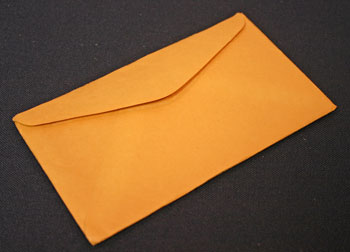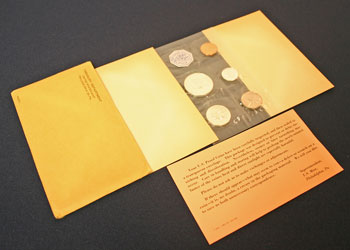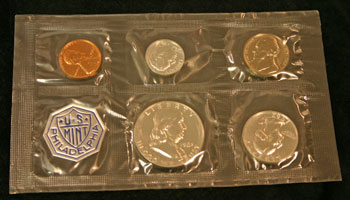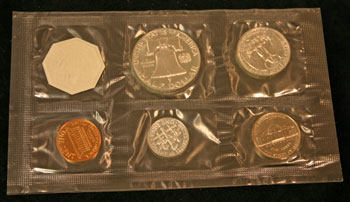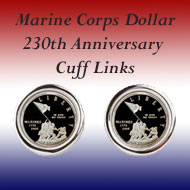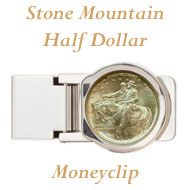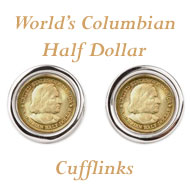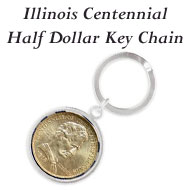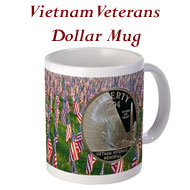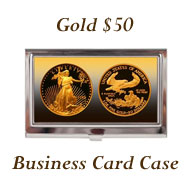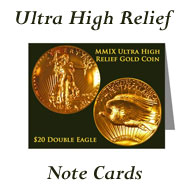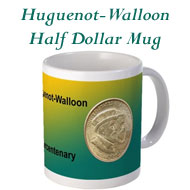|
Greater Atlanta Coin Show |
||
| coin show and coin information for collectors and investors | ||
Coins - 1962 Proof SetFor the 1962 Proof Set, the US Mint continued using the polyethylene-coated mylar inside a brown envelope. The proof coins were in separate compartments inside the sealed sleeve. Similar to 1961, interest in the proof set continued to be strong in 1962. The US Mint limited proof set orders to a maximum of 100. 1962 Proof Set PackageThis proof set package included a brown envelope 3.5 inches wide by 6 inches long. The upper left area, normally for the return address, shows: TREASURY DEPARTMENT The lower left corner of the front of the envelope says: 1962 P.C. where P.C. means "Proof Coins."
The back of the 1962 proof set lacked any identifying designs or marks on the envelope.
The 1962 Proof Set package compartmentalized five coins inside the mylar sandwich with a sixth area including an octagonal seal of silver foil on paper. The blue design on the foil background shows US MINT and three stars inside a shield with PHILADELPHIA underneath. The 1962 Proof Set's Half Dollar, Quarter Dollar and Dime consisted of 90% silver and 10% copper. The five cent coin (nickel) was made of 75% copper and 25% nickel, and the cent was 95% copper and 5% tin and zinc. (Tin was removed from the penny's composition in 1962.) 1962 Proof Set Contents and Proof CoinsTwo pieces of cardboard formed a sandwich around the flat coin set.
The US Mint included the precautionary note with the 1962 proof set like they did the previous year.
The note's contents varies slightly from the 1961 version. This one states:
The obverse of the coins:
The reverse:
Half Dollar: The 1962 half dollar continued with the Franklin image on the obverse. Franklin's image was first introduced in
1946 to remind people "that thrifty financial management is as important to individuals and to society today as it
was in Franklin’s time." Franklin's portrait facing right was developed from a composite of several portraits. The
words on the obverse include "LIBERTY" across the top and "IN GOD WE TRUST" under the portrait with the date to the
right of Franklin's neck. The coin's reverse shows the historic Liberty Bell hanging from its wooden beam with its
representative crack. The bell's image was adapted from a similar image used on a commemorative half dollar in 1926
for the Sesquicentennial of American Independence. "UNITED STATES oF AMERICA" circles the top half of the reverse
with the lettering "E Pluribus Unum" to the left of the bell and an American eagle with wings outspread to the
right. Below the bell, "HALF DOLLAR" is inscribed. (Instead of all capitals, a small "o" is used in "oF," however
it is placed at the top of the "F.") For fun, take a look at the initial Franklin Half Dollar Press Release Quarter Dollar: In 1962, the obverse design included the portrait of George Washington and the words: "LIBERTY," "IN GOD WE
TRUST" and the date. The US Mint introduced the quarter dollar with the portrait of our first president in 1932 to
commemorate the 200th anniversary of his birth. On the reverse, an eagle stands with wings
outspread clutching a bunch of arrows in its talons with two olive sprays crossed beneath his tail feathers. The
words on the reverse include: "UNITED STATES OF AMERICA," "E PLURIBUS UNUM" and "QUARTER DOLLAR." Dime: The 1962 dime's obverse shows an image of President Franklin Roosevelt. After his death in 1945 and many
requests to honor the late president, the US Mint released the Roosevelt dime on the late president's birth date in
1946. The words on the obverse include "LIBERTY," "IN GOD WE TRUST" and the year. The coin's reverse shows an olive
branch, a torch and an oak branch with the words "E PLURIBUS UNUM" across them. The words "UNITED STATES OF
AMERICA" flow around the top of the reverse with "ONE DIME" on the bottom. Five Cents (Nickel): The US Mint produced the first Jefferson nickels in 1938. The portrait of Jefferson on the coin's obverse copied
the portrait painted by Rembrandt Peale in 1800. Jefferson faces left in the portrait with the profile showing his
prominent forehead and colonial hair. The words on the face of the coin say "IN GOD WE TRUST," "LIBERTY" and the
year. The 1962 nickel's reverse shows Jefferson's historic home, Monticello, in Charlottesville, Virginia. "E
PLURIBUS UNUM" fits above Monticello, and "UNITED STATES OF AMERICA," "MONTICELLO" and "FIVE CENTS" show below the
home. Cent (Penny): The US Mint presented Abraham Lincoln's image on the obverse of the one cent coin in 1909 to commemorate the
100th anniversary year of his birth. The image shows Lincoln facing to the right in the portrait
with his iconic beard, suit coat and tie. The motto, "IN GOD WE TRUST" was first introduced on coins with the
Lincoln cent. The coin's obverse also includes "LIBERTY" and the date. The 1962 cent's reverse shows the Lincoln
Memorial. On the reverse, the inscription says "UNITED STATES oF AMERICA," "E PLURIBUS UNUM" and "ONE CENT." (Have
you noticed all the letters are capitalized except the "o" in "oF?") 1962 Proof Set Year Population and Cost of LivingThe world population in 1962 was 3,139,715,515. This represents 45.8% of the world's population in 2010. $100 in 1962 equals $722.04 in 2010 dollars using the Bureau of Labor Statistics' Inflation Calculator. New houses in 1962 cost an average of $18,200 which would be $131,411 in 2010 dollars. The average income was $4,291 per year which equals $30,986 in 2010 dollars. Gas was $0.306 per gallon which would be $2.209 in 2010 money. The average new car was $2,716 equivalent to $19,612 in 2010. (Chart views into the cost of living changes throughout the Proof Set years) |
Coin Shows GACS Numismatic Shoppe Contact Us Privacy Site Map |
© Copyright Atlanta Coin Expositions, 2008-2016. All Rights
Reserved.
Several of the links on the pages within this web site go to affiliate vendors.
A vendor affiliation can mean a small monetary compensation to the web site owner.


